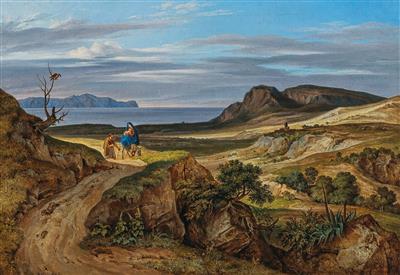Heinrich Reinhold

(Gera 1788–1825 Rome)
The Flight into Egypt, “Aus Sizilien - nach der Natur von Heinrich Reinhold” according to inscription on the reverse of the canvas, with inscription on the stretcher probably by the artist “Capo St. Vito von Borghetto her, 17 Miglien von Palermo”, signed Reinhold f., oil on canvas, 25.5 x 36 cm, framed (frame slightly damaged), (Rei)
Compare:
Heinrich Reinhold. Der Landschaft auf der Spur, ed. by Andreas Stolzenburg, Markus Bertsch, Hermann Mildenberger, catalogue of the exhibition held at Hamburger Kunsthalle and Klassik Stiftung Weimar, 7 December 2018 - 10 March 2019, Hirmer 2018, pp. 78–87, and cat. no. 131.
Künstlerhaus label 1898, 3949 confirmed by Mag. Paul Rachler.
Provenance:
Private Collection Vienna for five generations
The works of Heinrich Reinhold, who died at an early age, make an impression on the viewer with their fresh, nuanced rendering of landscapes and their displays of exquisite painterly skill, especially in the media of oil sketches and oil paintings. As a young artist, he longed for Italy: surrounded by the southern light and Mediterranean landscape, he blossomed and was able to fully develop his talent. His oeuvre that is available to us is not overly large due to his early death at the age of just 36, which makes the present painting a rare piece to come to market.
Reinhold came from a Thuringian family of artists and received his first training in the craft from his father, Johann Friedrich Leberecht Reinhold, as well as at Dresden’s Academy. After the death of his father, he followed his older half-brother Friedrich Philipp Reinhold, also a painter, to study at Vienna’s Academy. After finishing his studies and some work experience in Paris he made several trips to the Alps and devoted himself to in-depth landscape studies. Often, his painter friends Christoph Erhard and Johann Adam Klein also took part in these.
The seeds of his great desire to travel to Italy had already been sown during this period. Finally, Reinhold went to Rome in 1819, presumably encouraged by his fellow painter Franz Ludwig Catel. He found accommodation with the painter Johann Joachim Faber and his family in Via delle Quattro Fontane and quickly became part of the German artistic circle there, who met in Caffè Greco. In Rome, Reinhold was finally able to develop his artistic talents freely and made a name for himself among his artist colleagues for his oil studies en plein air and his lively renderings of the landscape. On his excursions and study trips through the Campagna and southern Italy, he created a large number of oil sketches, which soon earned him the reputation of being an outstanding landscape painter.
The present lot is based on his impressions of Sicily’s northern coast, the Cape of St. Vito. He travelled to Sicily via Naples and the Bay of Sorrento in April 1820. In addition to the ancient ruins of Taormina, Selinunte and Syracuse, they also visited Catania and Palermo.
The “Flight into Egypt”, however, was created four years later in his studio back in Rome. In the first few years after his arrival in the Eternal City, Reinhold struggled to keep himself above water; it was only around 1824 that his situation stabilised thanks to commissions and sales of paintings.The present lot also falls into this phase. The type of painting, depicting a landscape adorned with religious decoration, only appears in his late work and was perhaps inspired by the sculptor Bertel Thorvaldsen. Reinhold and Thorvaldsen were both Protestants and were members of the community of German-speaking Protestants in Rome.
The collection held by the Klassik Stiftung Weimar contains an unfinished oil painting depicting the same subject and of almost the same size. It comes from Reinhold’s estate in Rome and testifies to his technique of first arranging the composition on the primer by sketching out highly accurate outlines and then finishing it in oil paint. The Weimar version does not deviate from the painting up for auction here even in terms of the minor details of the vegetation in the foreground. The only difference comes in the form of the tree stump on the left, with a bird of prey sitting on its branch, which is merely sketched on the primer of the Weimar piece, whereas it is fully completed in our picture.
As a result, the obvious assumption would be that the present piece is the earlier of the two versions. The handwritten inscription on the back of the stretcher, “Capo St. Vito von Borghetto her, 17 Miglien von Palermo” [Cape St. Vito seen from Borghetto, 17 miles from Palermo], which geographically pin-points the landscape and could have been written by the artist himself, also suggests that this is the case. The inscription on the canvas “Aus Sizilien – nach der Natur von Heinrich Reinhold” [Sicily – from nature, by Heinrich Reinhold] also emphasises the landscape’s proximity to reality. In the background, Reinhold draws on his impressions of Sicily. This almost uninhabited landscape offers him an empty stage on which to position his biblical staffage figures, which open up a further dimension to the composition in terms of content.
Esperta: Mag. Dimitra Reimüller
 Mag. Dimitra Reimüller
Mag. Dimitra Reimüller
+43-1-515 60-355
19c.paintings@dorotheum.at
23.10.2019 - 17:00
- Prezzo realizzato: **
-
EUR 16.810,-
- Stima:
-
EUR 15.000,- a EUR 25.000,-
Heinrich Reinhold
(Gera 1788–1825 Rome)
The Flight into Egypt, “Aus Sizilien - nach der Natur von Heinrich Reinhold” according to inscription on the reverse of the canvas, with inscription on the stretcher probably by the artist “Capo St. Vito von Borghetto her, 17 Miglien von Palermo”, signed Reinhold f., oil on canvas, 25.5 x 36 cm, framed (frame slightly damaged), (Rei)
Compare:
Heinrich Reinhold. Der Landschaft auf der Spur, ed. by Andreas Stolzenburg, Markus Bertsch, Hermann Mildenberger, catalogue of the exhibition held at Hamburger Kunsthalle and Klassik Stiftung Weimar, 7 December 2018 - 10 March 2019, Hirmer 2018, pp. 78–87, and cat. no. 131.
Künstlerhaus label 1898, 3949 confirmed by Mag. Paul Rachler.
Provenance:
Private Collection Vienna for five generations
The works of Heinrich Reinhold, who died at an early age, make an impression on the viewer with their fresh, nuanced rendering of landscapes and their displays of exquisite painterly skill, especially in the media of oil sketches and oil paintings. As a young artist, he longed for Italy: surrounded by the southern light and Mediterranean landscape, he blossomed and was able to fully develop his talent. His oeuvre that is available to us is not overly large due to his early death at the age of just 36, which makes the present painting a rare piece to come to market.
Reinhold came from a Thuringian family of artists and received his first training in the craft from his father, Johann Friedrich Leberecht Reinhold, as well as at Dresden’s Academy. After the death of his father, he followed his older half-brother Friedrich Philipp Reinhold, also a painter, to study at Vienna’s Academy. After finishing his studies and some work experience in Paris he made several trips to the Alps and devoted himself to in-depth landscape studies. Often, his painter friends Christoph Erhard and Johann Adam Klein also took part in these.
The seeds of his great desire to travel to Italy had already been sown during this period. Finally, Reinhold went to Rome in 1819, presumably encouraged by his fellow painter Franz Ludwig Catel. He found accommodation with the painter Johann Joachim Faber and his family in Via delle Quattro Fontane and quickly became part of the German artistic circle there, who met in Caffè Greco. In Rome, Reinhold was finally able to develop his artistic talents freely and made a name for himself among his artist colleagues for his oil studies en plein air and his lively renderings of the landscape. On his excursions and study trips through the Campagna and southern Italy, he created a large number of oil sketches, which soon earned him the reputation of being an outstanding landscape painter.
The present lot is based on his impressions of Sicily’s northern coast, the Cape of St. Vito. He travelled to Sicily via Naples and the Bay of Sorrento in April 1820. In addition to the ancient ruins of Taormina, Selinunte and Syracuse, they also visited Catania and Palermo.
The “Flight into Egypt”, however, was created four years later in his studio back in Rome. In the first few years after his arrival in the Eternal City, Reinhold struggled to keep himself above water; it was only around 1824 that his situation stabilised thanks to commissions and sales of paintings.The present lot also falls into this phase. The type of painting, depicting a landscape adorned with religious decoration, only appears in his late work and was perhaps inspired by the sculptor Bertel Thorvaldsen. Reinhold and Thorvaldsen were both Protestants and were members of the community of German-speaking Protestants in Rome.
The collection held by the Klassik Stiftung Weimar contains an unfinished oil painting depicting the same subject and of almost the same size. It comes from Reinhold’s estate in Rome and testifies to his technique of first arranging the composition on the primer by sketching out highly accurate outlines and then finishing it in oil paint. The Weimar version does not deviate from the painting up for auction here even in terms of the minor details of the vegetation in the foreground. The only difference comes in the form of the tree stump on the left, with a bird of prey sitting on its branch, which is merely sketched on the primer of the Weimar piece, whereas it is fully completed in our picture.
As a result, the obvious assumption would be that the present piece is the earlier of the two versions. The handwritten inscription on the back of the stretcher, “Capo St. Vito von Borghetto her, 17 Miglien von Palermo” [Cape St. Vito seen from Borghetto, 17 miles from Palermo], which geographically pin-points the landscape and could have been written by the artist himself, also suggests that this is the case. The inscription on the canvas “Aus Sizilien – nach der Natur von Heinrich Reinhold” [Sicily – from nature, by Heinrich Reinhold] also emphasises the landscape’s proximity to reality. In the background, Reinhold draws on his impressions of Sicily. This almost uninhabited landscape offers him an empty stage on which to position his biblical staffage figures, which open up a further dimension to the composition in terms of content.
Esperta: Mag. Dimitra Reimüller
 Mag. Dimitra Reimüller
Mag. Dimitra Reimüller
+43-1-515 60-355
19c.paintings@dorotheum.at
|
Hotline dell'acquirente
lun-ven: 10.00 - 17.00
kundendienst@dorotheum.at +43 1 515 60 200 |
| Asta: | Dipinti dell’Ottocento |
| Tipo d'asta: | Asta in sala |
| Data: | 23.10.2019 - 17:00 |
| Luogo dell'asta: | Wien | Palais Dorotheum |
| Esposizione: | 12.10. - 23.10.2019 |
** Prezzo d'acquisto comprensivo di tassa di vendita e IVA
Non è più possibile effettuare un ordine di acquisto su Internet. L'asta è in preparazione o è già stata eseguita.
